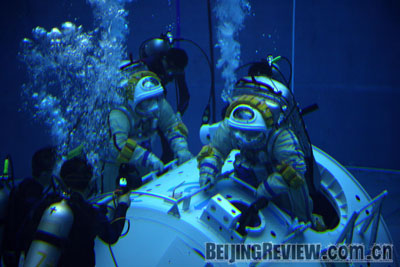|

AN EASY STROLL: Astronauts on the Shenzhou 7 mission emerge from
the spacecraft in an underwater training pool
With the launch date for the Shenzhou 7 manned spacecraft now set between September 25 and 30, the world's eyes will be on the first space walk by Chinese astronauts.
During the Shenzhou 7 flight one of the three astronauts on board will conduct a space walk to be broadcast live, said Zhao Changxi, a senior scientist with the project.
Although China successfully launched two manned spacecrafts in 2003 and 2005, respectively, the third space mission is different in terms of module design, spacesuits and scientific experiments, said Zhang Bainan, chief designer of the Shenzhou 7 spacecraft with the China Aerospace Science and Technology Corp.
Updated equipment
The airlock module is a new addition that is crucial to extravehicular activity because it serves as a transition between the pressurized orbital module and outer space. According to Shang Zhi, commander in chief of the spacecraft, the orbital module is pressurized to protect the crew while in space, so the airlock will be a site for pressure adjustments to maintain a balance between the inside and outside.
While they are outside the ship the astronauts will depend on their spacesuits, which provide a breathable atmosphere for living. According to the China Academy of Space Technology, the radiation-resistant spacesuits have a belt and tether to the orbital module through which communications and oxygen can be transferred.
Li Jian, Director of the Beijing Space Command and Control Center, revealed that the spaceship will hover 341 km above the Earth, and during the space walk it will release a small monitoring satellite to take digital pictures of the flying spacecraft.
Astronaut crew
At the Beijing-based Space Flight Center, the astronauts are making final preparations. In a large underwater training pool, an entire spacecraft is submerged so astronauts can practice maneuvering in conditions that simulate the low-gravity environment of space. The crew has also conducted multiple drills for other space experiments. To ensure the safety of the astronauts, the panel has come up with at least 30 emergency response plans concerning spacecraft malfunctions, said Zhang.
"All the major systems involved have entered the stage for final tests, and main tests for the spacecraft, the Long March 2F rocket, suits for the space walk and the monitoring satellite accompanying the mission all have been finished," a program spokesman said recently, adding that the ground control system--which includes the launch site, landing site and platforms for communication and observation--is in order. The Long March 2F rocket, which will serve as the launch vehicle, joined Shenzhou 7 at the Jiuquan Satellite Center in Gansu Province in August.
As a major step in China's three-phrase space project, China attaches great importance to the launch of Shenzhou 7. The mission could bolster the construction of large facilities like a space station and facilities maintenance with the assistance of space walk technologies. | 